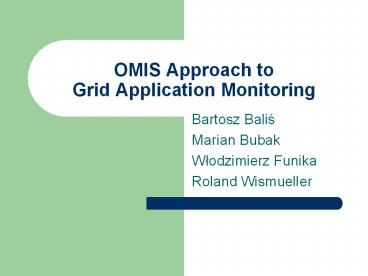OMIS Approach to Grid Application Monitoring - PowerPoint PPT Presentation
Title:
OMIS Approach to Grid Application Monitoring
Description:
on request, passed to local monitors ... storing and efficient data structures (counters and integrators) proved to be very efficient ... – PowerPoint PPT presentation
Number of Views:46
Avg rating:3.0/5.0
Title: OMIS Approach to Grid Application Monitoring
1
OMIS Approach to Grid Application Monitoring
- Bartosz Balis
- Marian Bubak
- Wlodzimierz Funika
- Roland Wismueller
2
AGENDA
- Introduction
- Monitoring architecture
- sensors (local monitors, application monitors)
- service managers
- Performance
- efficient data gathering
- scalability of grid-scale monitoring
- Producer / consumer communication protocol
- Comparison to DATAGRID
- Experience
- Conclusion
3
Introduction
- Need for monitoring applications
- improve performance
- localize bugs
- For these purposes specialized tools needed
- debuggers, performance analyzers, visualizers,
etc. - Tools composed of two modules
- user interface
- monitoring module
4
Introduction (contd)
- Main issues of monitoring on Grid
- scale of Grid enormous
- many applications, many users, high distribution,
high heterogeneity - simply porting existing environments not
sufficient! - A solution
- underlying universal monitoring system
- well defined interface to tools
- Experience with OMIS / OCM PVM ? MPI, port of
tools - next step move to Grid?
5
Monitoring architecture
- Compliance with GMA (Grid Monitoring
Architecture) - producer / consumer model
- Sensors producers of performance data
- Tools consumers of the data
- Direct communication between producers and
consumers - Producers located via e.g. a directory service
6
Sensors
- Collect performance data from applications
- Two types of sensors
- local monitors (process sensors)
- application monitors
7
Sensors (contd)
- Local monitors
- one per node
- collect data only from processes on this node
- publish themselves in the directory service
- Application monitors
- embedded parts of applications
- collect data on various events, e.g. function
calls - may improve efficiency and portability
- interact with local monitors
8
Monitoring Architecture
9
Service managers
- Tool local monitors one consumer, multiple
producers - Intermediate entity service manager
- handles requests coming from a tool
- splits them into sub-requests for local monitors
- collects replies from local monitors
- assembles them into a single reply for the tool
- Both producer (of data for tools) and consumer
(of data from local monitors) - Offers the functionality of local monitors but on
a per-application basis
10
Application Monitors
- Part of the monitoring system embedded in the
applications processes - have acces to the application address space!
- Many possible usages
- efficient data gathering and storing
- may take over some of the local monitors tasks
- may be used to dynamically load monitoring
extensions - even more for multithreaded applications
11
Application Monitors debugging example
- A debugger wants to access a process address
space - Standard system mechanisms ptrace, /proc
- /proc more powerful yet platfom-dependant
- synchronous control
- Via application monitors ? request from the
debugger to access the data - portable, asynchronous
- question how to ensure that application monitors
are not corrupted by the application?
12
Performance
- Efficient data gathering
- data production much more frequent than retrieval
- frequency and time of access difficult to
predict - Scalability
- grid-scale monitoring system
- distributed vs. centralized
13
Efficient data gathering
- Local storing
- performance data first stored locally, in the
context of application processes - on request, passed to local monitors
- saves communication and context switches between
application and local monitor processes - Efficient data structures
- performance data initially preprocessed
- summarized information stored in e.g. counters
and integrators
14
Scalability
- Decentralization ? multiple service managers
instead of one - Possible approaches
- fixed number of service managers, each
responsible for part of the system - one service manager starting for every monitored
application
15
Fixed number of SMs
16
One SM per application
17
Scalability (contd)
- In the first approach
- more tight cooperation between service managers
will be necessary - In the second approach
- local monitors must have the ability to serve
multiple service managers - service managers locate local monitors via
directory service
18
Communication protocol
- Based on the OMIS specification
- OMIS On-line Monitoring Interface Specification
- specification of a universal interface between
tools and a monitoring system - supports various types of tools
- allows for easy extending
- Necessary Grid-specific extensions (e.g. for
authentication)
19
Comparison to DATAGRID
- Monitoring approach
- DG (semi-)on-line
- CG on-line
- Architecture
- DG centralized distributed (local monitors and
one main monitor) - CG distributed (local monitors and multiple
service managers)
20
Comparison to DATAGRID (contd)
- Data collection
- DG local storing with trace buffering or
counters - CG local storing with preprocessing (counters,
integrators) - Communication protocol
- DG Not specified
- CG OMIS
21
Experience
- OMIS-based monitoring system for clusters of
workstations OCM - OMIS-based tools PATOP (performance analysis),
DETOP (debugging), others... - Local storing and efficient data structures
(counters and integrators) proved to be very
efficient - full monitoring overhead of about 4
- Instrumentation techniques used induce
zero-overhead when monitoring inactive
22
Summary
- Demand for accurate data from monitoring tools
- Monitoring data handling production /
consumption - A general scheme of monitoring compliant with GMA
- Need of an advanced monitoring infrastructure
- Concepts of OMIS will be extended to fit Grid































